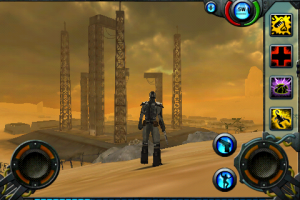First things first: if you’re thinking about giving Xenome: Episode I a go, double check the developer’s original iDevice recommendations before purchasing. Nine Pound Studios released an update on August 9 that added basic functionality for the iPod Touch 2G and 3G models with less than 32GB storage, but they’re still working out some serious kinks that cause lag and crashing with frightening frequency on these lower-end models. Word is that any iPod labeled “3G” by the seller – but which has less than 32GB storage space – will have the same processor as the old 2G model. My best guess is that the game is still being optimized for the older processor. If you have one of the above mentioned models of iPod Touch, definitely check in at Nine Pound Studios’ forum and ask about the game’s status on your device and OS.
 When it loads a New Game, the first thing Xenome: Episode I does is pose an intriguing question: “What happens when people stop dying?” One might be tempted to imagine some kind of utopia but Xenome quickly puts that idea to rest as the player’s avatar awakes in Silica Flats — a giant sandbox pocked with marks of ecological disaster following the discovery of a literal fountain of youth. Xenome‘s first episode offers no character creation, but it’s nevertheless a compelling setup from a storytelling perspective. The player controls a being called The Scientist, and he knows just as much about himself as the player does when he awakes from suspended animation. Which is: that he’s armed with a lot of scientific know-how but the fact that he’s eternally sealed inside a wetsuit and gas mask must mean there’s a bit more to him than meets the eye.
When it loads a New Game, the first thing Xenome: Episode I does is pose an intriguing question: “What happens when people stop dying?” One might be tempted to imagine some kind of utopia but Xenome quickly puts that idea to rest as the player’s avatar awakes in Silica Flats — a giant sandbox pocked with marks of ecological disaster following the discovery of a literal fountain of youth. Xenome‘s first episode offers no character creation, but it’s nevertheless a compelling setup from a storytelling perspective. The player controls a being called The Scientist, and he knows just as much about himself as the player does when he awakes from suspended animation. Which is: that he’s armed with a lot of scientific know-how but the fact that he’s eternally sealed inside a wetsuit and gas mask must mean there’s a bit more to him than meets the eye.
Soon after getting his first glimpse of Silica Flats, The Scientist is informed that he is alive but his helpful condition won’t last long unless he unflinchingly follows orders given him by the shady characters responsible for his resuscitation. Thus the player spends Xenome fulfilling requests from NPCs spread throughout this post-apocalyptic sandlot, gradually learning more about the complex game world Nine Pound Studios has built for its flagship franchise.
 On the one hand the manner in which Xenome‘s story plays out – through NPC banter and items containing records of the world’s history – allows its writers to remain mysterious and close vested to excellent effect. On the other hand, The Scientist’s eternal silence while he fills one dubious order after another quickly disabuses the player of any notion that Xenome means to deliver a structured narrative in the Final Fantasy vein; this is where the game begins treading squarely into Western RPG and MMORPG-like territory, character development taking the form of the player’s own internal reflection on his or her avatar’s activities. Regardless of storytelling preference all players will no doubt appreciate Xenome‘s excellent and generally witty text quality. I recall only a single grammatical typo, on its Game Over screen.
On the one hand the manner in which Xenome‘s story plays out – through NPC banter and items containing records of the world’s history – allows its writers to remain mysterious and close vested to excellent effect. On the other hand, The Scientist’s eternal silence while he fills one dubious order after another quickly disabuses the player of any notion that Xenome means to deliver a structured narrative in the Final Fantasy vein; this is where the game begins treading squarely into Western RPG and MMORPG-like territory, character development taking the form of the player’s own internal reflection on his or her avatar’s activities. Regardless of storytelling preference all players will no doubt appreciate Xenome‘s excellent and generally witty text quality. I recall only a single grammatical typo, on its Game Over screen.
The Scientist travels Silica Flats exclusively on foot with the aid of two virtual joysticks. The left joystick controls backward, forward, and sideways movement while the right controls his direction and angle of view. This will feel awkward for players unused to dual joystick setups, but when all is said and done it feels awfully nice to have absolute control over the camera in Xenome‘s 3D world. Separate virtual buttons offer jumping capability and allow access to menus, where the player can check task lists, view a handy world map, and arm and accessorize The Scientist through an intuitive drag and drop interface.
 The giant sandbox The Scientist has found himself in feels absolutely huge and packed with a variety of locations, but a nifty onscreen compass, warp points, and explicit goal symbols on the world map help the player keep his or her bearings. An autosave system records seemingly every important movement, item acquisition, and level up, so the iPhone user can take a call with absolute confidence that the game will pick up right where it left off. So far, so good.
The giant sandbox The Scientist has found himself in feels absolutely huge and packed with a variety of locations, but a nifty onscreen compass, warp points, and explicit goal symbols on the world map help the player keep his or her bearings. An autosave system records seemingly every important movement, item acquisition, and level up, so the iPhone user can take a call with absolute confidence that the game will pick up right where it left off. So far, so good.
The mysterious faction to which The Scientist owes his waking life seems to have a thinly veiled goal of depopulating Silica Flats of competitors, which means that the player will be engaging in lots and lots and lots of combat. The manner in which this plays out becomes Xenome‘s Achilles’ heel — the one factor likely to separate players who tolerate the game’s core mechanic from those who will quickly tire of it.
 When The Scientist encounters one of Silica Flats’ many hostile inhabitants, combat takes place in realtime and essentially boils down to the player pressing an auto-attack virtual button and kicking back with a soda while The Scientist and his adversary repetitively whale on each other, waiting for one combatant or the other to finally keel over. Player interaction during battle might include tapping virtual buttons on the right-hand side of the screen to insert special attacks or healing techniques between The Scientist’s less interesting automatic strikes. Gamers well steeped in the MMORPG genre have no doubt already experienced similar combat systems but gamers who desire something a bit more active and engrossing are sure to cringe the second time they receive an order to hunt down giant mutant cactuses.
When The Scientist encounters one of Silica Flats’ many hostile inhabitants, combat takes place in realtime and essentially boils down to the player pressing an auto-attack virtual button and kicking back with a soda while The Scientist and his adversary repetitively whale on each other, waiting for one combatant or the other to finally keel over. Player interaction during battle might include tapping virtual buttons on the right-hand side of the screen to insert special attacks or healing techniques between The Scientist’s less interesting automatic strikes. Gamers well steeped in the MMORPG genre have no doubt already experienced similar combat systems but gamers who desire something a bit more active and engrossing are sure to cringe the second time they receive an order to hunt down giant mutant cactuses.
It’s sad that the repetitive nature of questing and combat will drag down the quality of Xenome for some because the ancillary gameplay elements are all very solid. The Scientist can collect or purchase a veritable mountain of different equipment from felled adversaries and desert vendors, and even absorb enemy abilities by applying xenomes to himself — think “genome,” but extracted from one organism and applied to another. Difficulty feels balanced due to the fact that The Scientist gains experience points from both quest completion and combat, and he is free to pursue quests in nonlinear order once the player begins mingling with more and more NPCs.
Aesthetically, Xenome comfortably surmounts the fact that Silica Flats is essentially a giant sandbox. Oases, vagabond strongholds, and eerie remnants of civilization lend the world much needed variety and dystopian charm. Rather than split Silica Flats into clearly segmented areas, Nine Pound Studios opted for a contiguous world in which new areas are loaded on-the-fly as The Scientist approaches. The one nasty side effect of Silica Flats’ seamlessness is that it demands a single music track for much of the game’s average 10 to 15 hour length. It’s a nice mellow track suited for a walk in the desert but the player will certainly feel tempted to break out tracks from his or her own iTunes list — a perfectly welcome move, since Xenome allows separate control over in game music and sound effects.
iFanzine Verdict: Xenome: Episode I sports a fleshed out and thoroughly interesting sci-fi scenario, but unfortunately its gameplay rests largely on ultra-repetitive questing that even MMORPG veterans may find tiresome absent the character creation and multiplayer interaction they’ve long associated with the kind of combat system on offer here. Nine Pound Studios intends on making numerous forays into Silica Flats and beyond, so we look forward to seeing how future episodes will improve on the formula established here.


